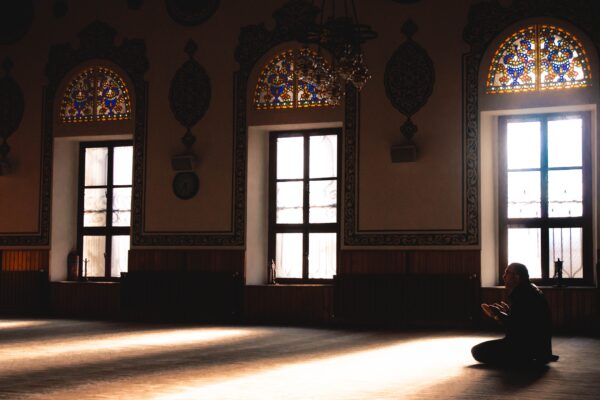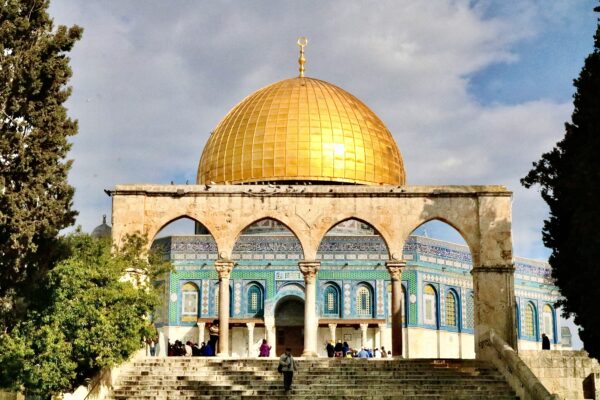This verse takes individuals out of the darkness and puts them in light, whilst those who are already guided, their light is increased.
This verse takes individuals out of the darkness and puts them in light, whilst those who are already guided, their light is increased.
(This is part one in a series analysing the opening surah in the Holy Quran, Al-Fatiha)
On a daily basis Muslims recite Surah Al-Fatiha a minimum of 10 times in their prayers, in fact, no prayer is valid without the recitation of this chapter of the Holy Qur’an.[1] The first chapter of the last divine scripture, the chapter of Al-Fatiha, is one of the most important chapters in the Qur’an and according to some traditions it is the most superior chapter revealed out of all the divinely revealed scriptures.[2]
The majority of scholars believe that Surah Al-Fatiha was revealed in Mecca, whilst others are of the opinion that it was in Medina. A minority believe that it was revealed in both Mecca and Medina. However, this does not have any practical implications or impact on the explanation of the verses. It is vital for each individual to take time and reflect upon the significance of each of the 7 verses of this chapter, to understand the meaning behind the most superior chapter revealed to the final Messenger, Prophet Mohammed (saw).
Many of us have been reciting this chapter since childhood; however how much do we really understand from the verses of this chapter? Does the recitation of these verses have any practical implication on our lives? In this series of articles, we shall be exploring some of the meanings behind each of the verses of this chapter based on the explanations given by the exegeses, in addition to analysing their practical implications.
It is imperative to first discuss the importance and virtues of this surah, as according to some exegesis, Surah Al-Fatiha was the first complete chapter revealed to the Prophet (saw) thus highlighting its significance.
In one narration, the Messenger (saw) is reported to have asked Jabir: “shall I teach you the best chapter which Allah (swt) has revealed in His book. Jabir replied yes, please teach me, Oh Messenger of God, and the Prophet (saw) taught him the chapter of al-Hamd (i.e. Al-Fatiha), which is Umm al-Kitab” (Mother of the book).[3]
In other traditions, it has also been narrated that if the chapter of Al-Fatiha was to be put on one side of the scale and the remainder of the Qur’an was to be placed on the other side of the scale, this chapter would outweigh the Qur’an seven times.[4] Furthermore, Ali ibn Abi Talib in one tradition is reported to have said that everything in the Qur’an can be found in the chapter of Fatiha al-Kitab[5]. Additionally, the one who recites this chapter gets the reward of an individual who has recited the whole of the Qur’an.[6]
The second area of discussion relating to the introduction of this chapter explores the names given to Surah Al-Fatiha, which each represent a dimension and a characteristic attributed to the chapter. There are narrations of as many as 25 names given to this chapter such as Umm Al-Kitab, Al-Asaas, Al-Shifa, Fatiha Al-Kitab, Al-Wafiya, Al-Kafiya, Al-Salat, Al-Du’a, Al-Shukr, Al-Kanz, Al-Munajat, Al-Tafwidh Al-Noor amongst many others. Here, we shall mention and explain a few of these:
Umm Al-Kitab (Mother of the book): In the Arabic language the term Umm (Mother) is used to describe that which is the origin or root of other things. Thus as Surah Al-Fatiha is the origin and root of all other concepts found in the Holy Book, it is referred to as Umm al-Kitab.[7]
Al-Shifa (The Cure): Indeed the realities and concepts found in this chapter are healing for all illnesses. If we have full faith in the verses of this chapter and recognise that Allah (swt) is the ultimate Healer (Al-Shafi), it can act as a cure for both physical and spiritual diseases. Prophet Mohammad (saw) has said: “Verily the chapter of Fatiha is a cure for every illness”.[8] The Qu’ran is also a healer for both external and internal illnesses as it states: “We send down (stage by stage) in the Qur’an that which is a healing and a mercy to those who believe…” (17:82), in another verse, it also mentions: “O mankind! There hath come to you a direction from your Lord and a healing for the (diseases) in your hearts…” (10:57). Therefore, based on how much we live the verses of this chapter, we will benefit from the cure found within them.
Al-Asaas (The Basis): Surah Al-Fatiha discusses three main phases of creation; the first is the beginning (Mabda’) which goes back to the names and attributes of Allah (swt). The second looks at the end and resurrection (Ma’ad). Finally, it touches upon how one must live between the two aforementioned stages, i.e. following the guidance provided through prophet-hood.[9] Moreover, it is also known as the basis of the Qur’an as it has been described as such in the traditions: “Verily everything has a basis, and the basis of the Qur’an is the chapter of Fatiha”[10]
Al-Noor (The Light): This chapter guides the human being through the light it has. It takes individuals out of the darkness and puts them in light, whilst those who are already guided, their light is increased. The Qur’an in its entirety also has this characteristic as it is mentioned: “Believe, therefore, in Allah and His Messenger, and in the Light which we have sent down…” (64:8), in another verse, Allah (swt) explains the role of the Qur’an: “… We have revealed unto thee, in order that thou mightest lead mankind out of the depths of darkness into light…” (14:1), and in order to be able to benefit from this light, we need to follow it: “…So it is those who believe in him, honour him, help him, and follow the light which is sent down with him…” (7:157).
In the next part of this series, we will analyse the first verse of Surah Al-Fatiha, in addition to discussing the philosophy behind starting everything in the name of The Creator.
[1]‘Awali al-Li’ali, V1, p.196
[2] Mustadrak al-Wasa’il, V4
[3] Jami’ al-Ahadith al-Shi’a, V15, p89
[4] Mustadrak al-Wasa’il, V4, p.330
[5] Bayan al-Ayaat, p.33
[6] Noor al-Thaqalayn, V1, p.4
[7] Tasnim, V1, p.260
[8] Majma’ al-Bayan, V 1, p.87
[9] Tasnim, V1, p.270
[10] Majma’ al-Bayan, V 1, p.87
by Mohammad Ehsan Rangiha for Voice Of Unity





